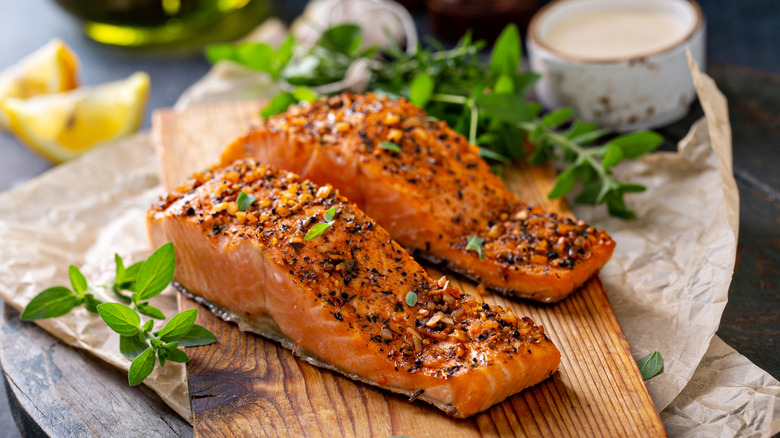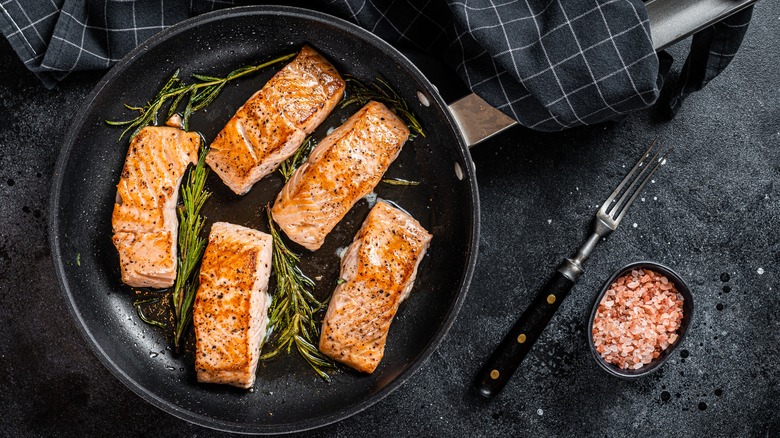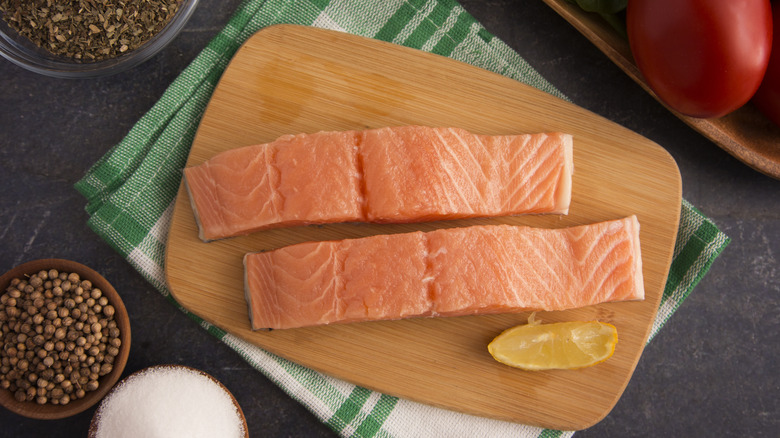Why Cooking Salmon Fillets Close To Each Other Helps Them Retain Moisture
Salmon is a favorite for home cooking from Tokyo to Toronto, but when it comes to cooking salmon in a pan or oven, getting it perfectly moist can prove challenging. If it's undercooked at first then that's no big disaster: You can always cook your fillets for a couple of minutes more. However, making sure salmon doesn't end up overcooked and overly dry can be more of a challenge.
Salmon, or any fish for that matter, contains water molecules that expand and evaporate when heated, causing your fillets to shrink and dry out. Some moisture loss is natural and unavoidable, but if this continues too long the result is overcooked fish. To avoid a dry, overcooked piece of salmon, you need to find ways to retain moisture during the cooking process.
One interesting method to reduce moisture loss is to place your salmon fillets close to each other in the pan, oven, or on the grill. Cookery saint and British national treasure Mary Berry has championed this method, so you know there's something to it.
How does placing fillets close together keep them moist?
This method rolls a few different moisture-retaining benefits into one simple action. Firstly, just like how penguins huddle together to protect themselves from extreme cold, multiple salmon fillets are better insulated from extreme heat when they touch. At the same time, less open space in the pan means there's less hot air circulating around a fillet, which reduces moisture loss from your fillets through evaporation. And, when the fillets do release moisture, it's getting released onto the fillet next it, not just into the empty air space.
However, bear in mind that when cooking multiple fillets at once, the same amount of heat from your pan is now spread between more fillets. This means they'll take longer to cook than if you were just cooking one. However, so long as you can identify when each fillet is fully cooked, you shouldn't have much to worry about.
Not everyone likes their salmon cooked the same way, but generally, you're aiming for a salmon that's nice and moist, even a little juicy. This is achieved in the medium-rare to medium range of doneness. Although it's recommended to cook fish to an internal temperature of 145 degrees Fahrenheit, if you want to grill salmon perfectly, for medium-rare salmon use a thermometer and check for an internal temperature of 125 degrees Fahrenheit.
More tips to keep your salmon fillets moist
What salmon you buy will impact your results. Farm-raised salmon contains much more fat than wild salmon, and this fat is your friend when it comes to moisture retention as the fat helps prevent the fillet from drying out. Plus, it's also cheaper than the wild stuff!
Next, before you start cooking, consider adding other items under or alongside your salmon to form a natural barrier from direct heat. Oil, herbs, slices of citrus, and the salmon skin itself are all barriers that slow moisture loss when cooking. Alternatively, make a parchment paper parcel for your salmon and bake it en papillote, a technique that locks in moisture fantastically.
Another useful tip: Salt your fish just before you cook it — not any earlier. Salt draws moisture out of your salmon, so doing this too early will dry it out more than is necessary. Also, the pan you use matters. Different pans or skillets transfer heat differently, so use a pan you're familiar with, and give it some time to come up to heat before adding the fish. Whether cooking salmon in a pan or on the grill, a consistent medium-high heat is going to give you the best results.
Once your fish goes in the pan, resist the urge to move it around. Whether you're grilling fish or frying, start skin-side down, flip it just once, and cook for less time on the skinless side so you don't dry the fillets out too much.


